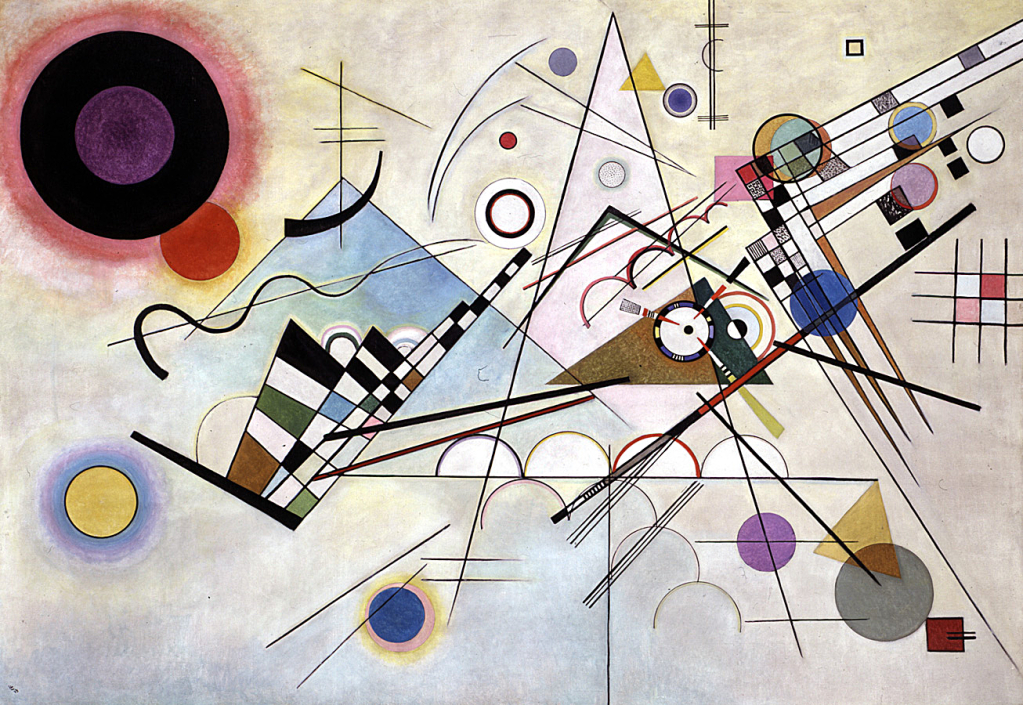Kandinsky in Context
07.05.2002 - 01.19.2003
In the first decades of the 20th century as painting was becoming increasingly abstract, Vasily Kandinsky (1866–1944) and his theory of a non-objective approach to art altered the course of painting. Spanning five decades, Kandinsky's career as a painter, a teacher, a writer, a poet, and an exhibition organizer brought him into contact with diverse artistic and intellectual currents. This exhibition explores the relationships between the work of Kandinsky and that of his contemporaries through more than 90 paintings, works on paper, and sculptures from the Solomon R. Guggenheim Museum's vast early 20th-century holdings.
Born in Moscow in 1866, Kandinsky moved at the age of 29 to Munich, where he would spend much of the next 18 years. From 1901 to 1903 he taught at the art school of the Phalanx, a group he had cofounded, and it was during this period that he produced his first woodcuts. In 1911, Kandinsky published his book On the Spiritual in Art (Über das Geistige in der Kunst), which intimated that a higher moral existence might be communicated through art, and more specifically, through the language of abstraction. During the same year, Kandinsky and artist Franz Marc conceived Der Blaue Reiter Almanac, a revolutionary journal that attempted to synthesize the arts in order to reinvigorate society. Emblematic of the group's hope for dynamic transformation, the horse-with or without a rider-was a common motif and is prominently figured in Marc's Stables (Stallungen) (1913) while subtly suggested in Kandinsky's Painting with White Border (Bild mit weissem Rand) (1913). An exhibition by the Blaue Reiter group was held at the end of 1911.
Kandinsky lived in Russia from 1914 to 1921, during which time he was closely associated with artistic leaders of the avant-garde, including El Lissitzky, Kazimir Malevich, and Aleksandr Rodchenko. He assumed a position at the People's Commissariat of Education and established the Moscow Institute of Artistic Culture (INKhUK). As part of the Institute's program, Kandinsky advocated an objective, analytic approach to artistic study. In 1922, he began teaching at Germany's Bauhaus in Weimar, a school founded in 1919 that espoused utopian theories of art and architecture. During the early 1920s, Kandinsky began to move away from representation toward pure abstraction, incorporating strict geometric forms that can be seen in Composition 8 (Komposition 8) (1923). Josef Albers, Paul Klee, and László Moholy-Nagy were among the faculty at the Bauhaus and applied similar rigid geometry in their work. Kandinsky moved with the Bauhaus to Dessau in 1925 and became a German citizen in 1928. The Nazi government closed the Bauhaus in 1933, and later that year Kandinsky settled in Neuilly-sur-Seine, near Paris.
Kandinsky thought his paintings would find a market in Paris, which he believed to be the artistic capital. However, his work was neither sufficiently understood nor acclaimed by the Parisian public. Nonetheless, he was aligned with two distinct groups during the course of his later career. The Surrealists' amorphous forms, visible in Jean Arp's Constellation with Five White Forms and Two Black, Variation III (Constellation aux cinq formes blanches et deux noires, variation III) (1932), undoubtedly inspired Kandinsky's organic compositions of this period. Abstraction-Création, a group that championed a nonfigurative aesthetic found in works by Piet Mondrian and Georges Vantongerloo, also appealed to Kandinsky, but the group's insistence on art's purity and divorce from nature were at odds with his philosophy. It was within this vibrant artistic community in Neuilly-sur-Seine that the artist died in 1944.
The works in this exhibition demonstrate both the centrality of Vasily Kandinsky's role in the formation of the Solomon R. Guggenheim Museum's collection, which includes more than 150 of his works, and the increasingly complex relationship between abstraction and figuration in 20th-century art. Articulated by the museum's first director Hilla Rebay and epitomized in Kandinsky's work, the aesthetic vision of a pure, painterly abstraction served as the catalyst for the formation of a remarkable collection that has grown to include a deep and broad assembly of Modern and contemporary masterpieces.
Vasily Kandinsky
Composition 8 (Komposition 8), July 1923
Oil on canvas
140 x 201 cm
Solomon R. Guggenheim Museum, New York
Solomon R. Guggenheim Founding Collection, By gift

